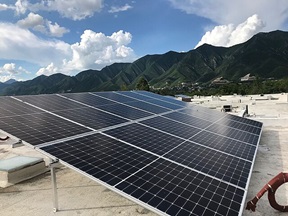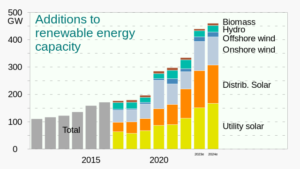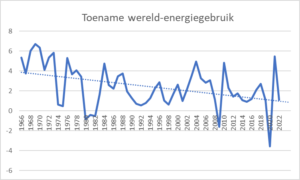Renewable energy, mainly solar, wind and hydro, is going to take over global energy supply. But is its development fast enough to prevent global warming beyond 1.5oC?

Global annual renewable energy capacity additions are on a record track. In 2023, these additions increased by almost 50% to nearly 510 gigawatts (GW). This is the fastest growth rate in the past two decades; and the 22nd year in a row that renewable capacity additions set a new record. PV additions account for three quarters of renewable additions. Among these, China’s performance is extraordinary. In 2023, the country commissioned as much solar PV as the entire world in 2022. Also the United States, Europe and Brazil hit new records.
Continuing development
And solar performance shows no signs of slowing down. Solar is now cheaper than either fossil or nuclear power. If the present pace of development continues, the world could install as much as 1,000 GW (1 TW) in 2027. Nevertheless, not all is sunshine. Grid bottlenecks become a key barrier to solar development: because of limited grid capacity, or a lack of flexibility and storage in national electricity systems.
The latest IEA report on renewable energy calls for tripling renewable capacity by 2030, in order to stay in line with IEA’s Net Zero Emissions scenario. But, however fast present developments are, these are not fast enough to attain that goal. Because of policy uncertainties, insufficient investment in grid infrastructure, cumbersome administrative barriers and insufficient financing in emerging and developing economies.
Net Zero Emissions scenario
If these challenges are met, the world could be on track towards the Net Zero Emissions scenario. This doesn’t just concern developed countries – developing countries need to fulfil their promises as well. Solar and wind will contribute some 95% of new renewable energy capacity.
- In 2024, wind and solar PV together generate more electricity than hydropower
- In 2025, renewables will surpass coal and become the largest source of electricity generation.
China’s role is critical in these developments. The country will account for almost 60% of new renewable energy capacity until 2028. By 2030, almost half of China’s electricity generation will come from renewable energy sources. China will also remain the main manufacturer of solar equipment. Even though manufacturing in the United States, India and the European Union grows fast, China is expected to maintain a share of at least 80% of global capacity.

Renewable energy: lower price
In 2023, wind and solar PV economically outperformed coal and natural gas plants – they generated electricity at a lower price. Even though they require additional investments to make up for their variable character. But renewable expansion is being challenged from another side: interest rates. Higher interest rates increase the financing costs of capital-intensive renewable technologies. Several auctions of wind energy projects, particularly in Europe, were therefore undersubscribed. In order to meet this challenge, the European Union adopted a Wind Power Action Plan in October 2023, aiming to enhance competitiveness. Nevertheless, forecasts for onshore wind projects have been revised downwards.
In Europe, transnational grid connections help in easing out differences in load factor. These inevitably occur due to the intermittency of renewable energy sources. Nevertheless, grid bottlenecks will challenge further installation of the variable renewables. Grid expansion cannot keep pace with the fast installation of renewables – true for both wind and solar energy. Hydrogen has problems in easing out these variations: new projects are being announced, but their realization is slow.
Biofuel
In many third world countries, particularly Brazil, renewable energy consists primarily of biofuel. This is mainly used in the transport sector. In some countries, the biofuel sector accounts for up to 90% of the expansion of renewables. In other countries, again the United States, Europe and China, electric vehicles drive expansion of renewables in the transport sector. Faster biofuel use – including jet fuel – will require additional policies, and addressing supply chain challenges.
The most important sector by volume, industrial and residential heat, will be assisted by stronger policies. At present, according to the IEA, 17% of total heat consumption comes from renewables (and growing). This is due to growing reliance on sustainably sourced electricity, and the deployment of heat pumps and boilers in buildings. Almost 17 million more European homes were powered by solar in 2023, due to a 40% growth in solar installations from 2022. Compared to the 40 GW of solar installed in 2022, 2023 brought 55.9 GW of new solar capacity across the EU 27. Policy supports this development, through targets and financial incentives.

Stronger policies required
But still, according to the IEA, present trends are not strong enough to limit global warming to 1.5oC. Global energy use still rises, although considerably less than before; in 2022 by 2.1%. Even though energy intensity falls (by 1.2% in 2022). We’re on course to zero energy growth around 2040. But in order to limit global warming to 1.5oC or even 2oC, we need stronger policies. Faster growth in renewable heat production; wide-scale demand measures; and much improved energy and material efficiency improvements. We are not yet on track towards a sustainable energy future!
Interesting? Then also read:
Perspective on renewable energy rapidly changing
A common sense or 50-50-40 energy scenario. Part 2: renewable energy
Solar energy will soon dominate the energy system
